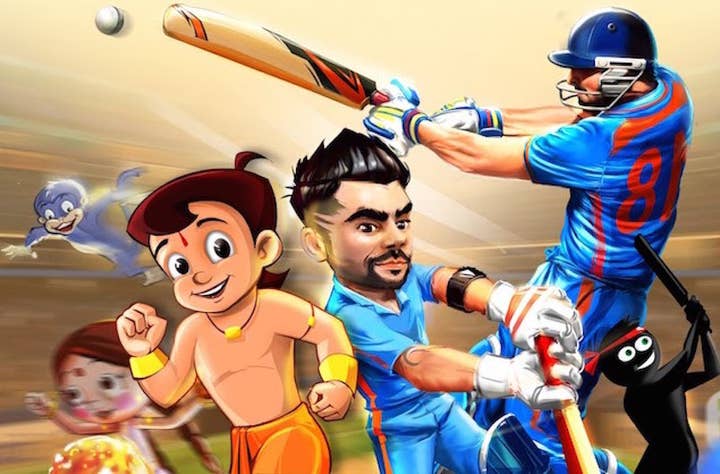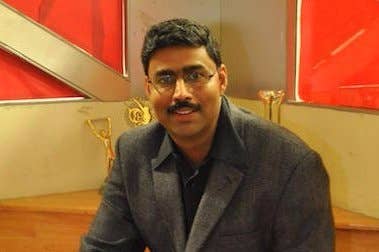“We're not taking a bet on six months. We're taking a bet on five years"
Nazara Technologies' Manish Agarwal on realising the potential of India's 1.2 billion population as a market for games
The influence of Bollywood cinema is so pervasive in India that you feel it before you even hit the ground. Should you be fortunate enough to take a trip to the world's second most populous country, and should your flight be with Air India, be sure to opt for a seat at the back. Despite the broad array of Hollywood movies on offer, you won't see Tom Cruise or Jennifer Lawrence on more than a handful of the dozens of screens illuminating the darkness in front of you. What you will see are elaborate costumes, intricate dance routines and melodrama of the ripest sort. On my own flight to Delhi I was treated to a Bollywood Rocky, a Bollywood Saving Private Ryan, and a host of stories that have no obvious corollary in Hollywood. It was a reminder that, while the US may be the primary source of cinema for much of the world, Indians do entertainment their own way.
"We are playing an eyeballs game. If you're the guy helping them to play their first game, and then the second, and then the fifth, you're creating a network"
One of the more stimulating questions asked at this year's NASSCOM Game Developer Conference was whether the content produced by India's emerging games industry would follow that tradition. Addressing a room of Indian journalists, Rajesh Rao, co-founder of Dhruva Interactive and the chair of the NASSCOM Gaming Forum, left little room for discussion.
"I'm pretty clear about this," he said. "If you look at the film industry in India, it is dominated by Indian content. Television, dominated by Indian content. Music, dominated by Indian content. Unlike in some other countries where Hollywood has destroyed the local film industry, that has not and will not happen in India. We like to tell stories our way... If there is a games industry that will become mass market, I have no doubts that it will be dominated by Indian content, too."
Rao's comments are very much in mind when I meet with Manish Agarwal, CEO of Nazara Games, one of the leading companies in the Indian games industry. Agarwal is a firm believer that India can become one of the world's largest markets for mobile games specifically, but that objective will only be achieved with the sort of local IP that is all but impossible to find on the Apple and Google app stores right now. "We believe that the market is going to explode," he says, "and there is a huge need gap for good quality local content."

Nazara's position opposes that held by many independent developers at NASSCOM. According to a report published during the conference, 75 per cent of the country's developers are focused on creating content for the international mobile market. Prior to meeting with Agarwal, SuperSike's Amit Ghoyal told me that, "India plays what everybody else plays... There is a bigger chance for an Indian game to go up the charts by being an international viral hit." Ghoyal was just one of many indies to express this view, but Agarwal sees it as a perspective informed by resources and scale. Whatever the Indian market seems to demand right now, he says, will be entirely different in just a few years time.
"India is a data sensitive market. Gaming picks up at night. Gaming picks up on weekends"
"We're not taking a bet on six months. We're taking a bet on five years. The scale of Nazara allows us to take that bet on five years, while indies have to take the bet of six months. That's why the indies are looking outside towards the US market. They are looking for the immediate cash.
"In India, the top 30 or 40 million people, because of the English language, they're very well travelled globally, and hence the content they are watching on digital platforms is western content. In their own perspective, they are very global. However, if you look at the 1.1 billion people, who are not global in their perspective, they are watching local content.
"So, as gaming moves from early adopter to early majority to late majority in the future, the late majority guys do not know western content. They are not exposed to western culture. They only understand the Indian stars, Indian IPs, Indian mythology, Indian sports. When you are creating content around these things, the discovery and the familiarity is very easy."
According to Agarwal, many of India's independent developers are basing their assessment of the local market on the minority of people who already have access to a smartphone, who ascribe aspirational value to global brands like Candy Crush, Angry Birds and Temple Run. However, according to NASSCOM's data, India will add around 100 million smartphone users every single year to the 200 million that already exist at the close of 2015. These new users, Agarwal says, own budget smartphones, and may even be encountering the internet for the first time in their lives. Facebook, Whatsapp and playing video are the leading activities, with gaming closing ground from a distant fourth place. Data is generally purchased in what Agarwal describes as "weekend packs," and turned on and off as needed. Data hungry activities, like playing an online game or updating an offline game, are treated as an event, like going to the movies.
"India is a data sensitive market," he says. "Gaming picks up at night. Gaming picks up on weekends. From weekday to weekend there's a 40 per cent rise."
"We believe that the market is going to explode, and there is a huge need gap for good quality local content"
This is where the notion that an international hit can be a hit for India falls down - at least, it does if you view India as a potential market of hundreds of millions of people, rather than just an existing market of tens of millions. These conditions inform Nazara's entire business model, which is based around third-party development and licensing. At present, Nazara won't consider a game with an APK file size above 20MB, and it won't publish anything that can't provide a rewarding experience offline.
The final aspect, and arguably the most important, relates to monetisation: to work with Nazara, a developer must see brand integration and reward videos as fundamental to the way their games works. With credit-card penetration in the country at just 2 per cent and carrier billing only just starting to take root, only a tiny fraction of the country can make in-app purchases. For independent studios working with limited resources, this leaves little choice but to cater to the more free-spending markets elsewhere in the world. For Nazara, however, the aim is very different, and that's reflected in its monetisation model, which Agarwal sees as closer to the way brand advertising funds the creation of content on television.
"We are playing an eyeballs game," he says, referring again to the imminent explosion in the size of India's gaming audience. "If you're the guy helping them to play their first game, and then the second, and then the fifth, you're creating a network - of users, and of developers."

Which bring us back to Bollywood, and the necessity of local content in building an audience that truly reflects India's size. The most obvious western comparison for Nazara's product strategy is Glu Mobile, with games based on some of the most valuable and recognisable Indian IP. "We have signed the biggest kids IP, Chhota Bheem - it's bigger than Disney in this market. We've signed the captain of the Indian cricket team. We've signed the biggest TV IP. We've signed one of the most popular comic characters, which has been alive for more than 50 years, and we're in talks to sign a couple of big Bollywood names.
"I kid you not, in 24 months we will meet in this conference, and your questions about Bollywood and games will have been answered"
"This is a distribution game, a volume game, a sachet pricing game. But more importantly, from a mindset point-of-view, it's a patience game"
Whether international companies are asking the same questions remains unclear, however. With NASSCOM GDC in full swing, Nazara announced an exclusive deal with Zeptolab to publish games from the Cut The Rope franchise in India, including "complete tech ownership of the source code." This will allow fundamental alterations to the games' mechanics and aesthetic, bringing them more in line with local culture and sensibilities. This is a great deal for Nazara, but Agarwal also sees it as one of the first examples of a global company understanding what's required to make progress in the Indian market.
"The Zeptolab guys, they are very clear that if they want to increase from, say, 1 million MAUs in India to 50 million MAUs, they need a local partner that understands the local culture," he says. "The licensing and merchandising deals that you could cut, they're really going to be huge in India. Some guys are making the mistake of just looking at IAP revenues. They are taking a very short-term view. What they are missing is the bigger picture of building a brand in a country that is going to have 700 million people in its middle-class, where you print your brand on a pencil, on a t-shirt, on a lunchbox, on every damn thing. That's a far bigger opportunity that just looking at IAP.
"I meet a lot of international players. They come to India thinking there are 500 million people with their purses out, and they're going to spend money. Then, after six, twelve, eighteen months, they get frustrated and they leave. When they seek my advice, I tell them that you need to be patient with India.
"This is a distribution game, a volume game, a sachet pricing game. But more importantly, from a mindset point-of-view, it's a patience game."

